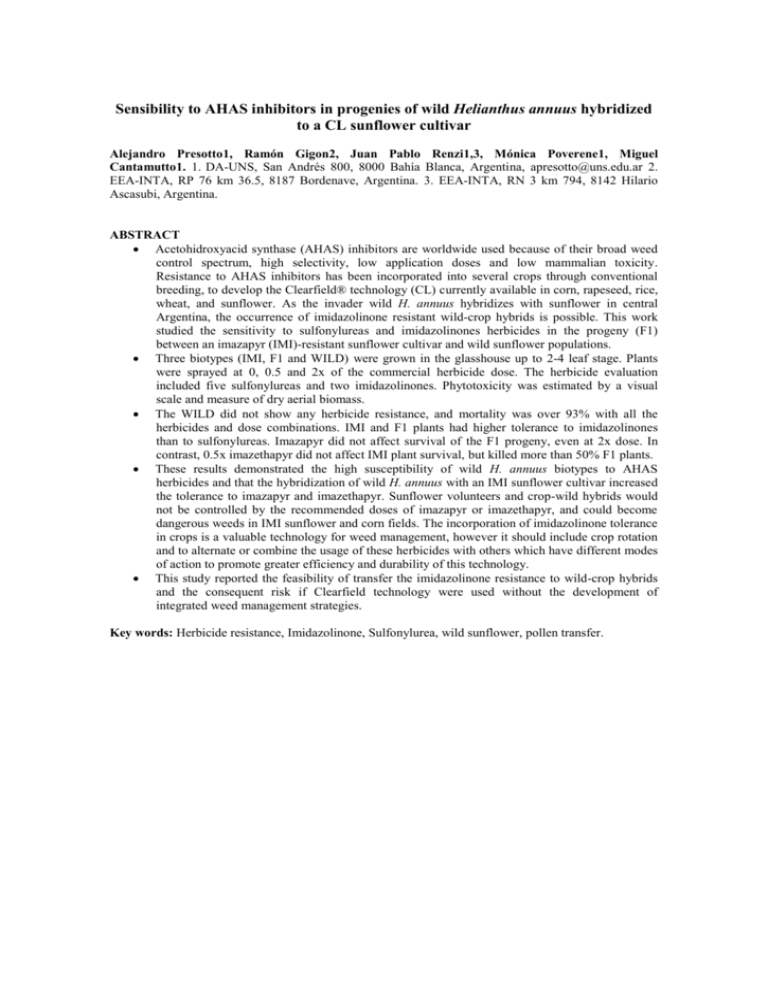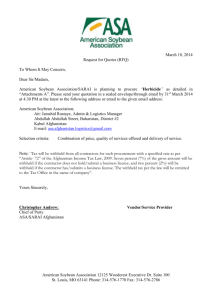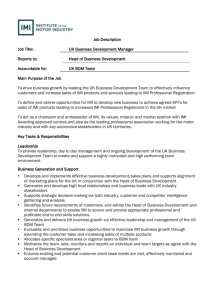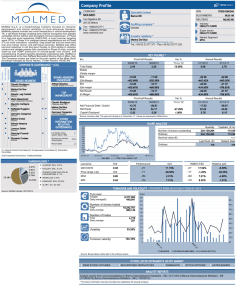Sensibility to AHAS inhibitors in progenies of wild
advertisement

Sensibility to AHAS inhibitors in progenies of wild Helianthus annuus hybridized to a CL sunflower cultivar Alejandro Presotto1, Ramón Gigon2, Juan Pablo Renzi1,3, Mónica Poverene1, Miguel Cantamutto1. 1. DA-UNS, San Andrés 800, 8000 Bahía Blanca, Argentina, apresotto@uns.edu.ar 2. EEA-INTA, RP 76 km 36.5, 8187 Bordenave, Argentina. 3. EEA-INTA, RN 3 km 794, 8142 Hilario Ascasubi, Argentina. ABSTRACT Acetohidroxyacid synthase (AHAS) inhibitors are worldwide used because of their broad weed control spectrum, high selectivity, low application doses and low mammalian toxicity. Resistance to AHAS inhibitors has been incorporated into several crops through conventional breeding, to develop the Clearfield® technology (CL) currently available in corn, rapeseed, rice, wheat, and sunflower. As the invader wild H. annuus hybridizes with sunflower in central Argentina, the occurrence of imidazolinone resistant wild-crop hybrids is possible. This work studied the sensitivity to sulfonylureas and imidazolinones herbicides in the progeny (F1) between an imazapyr (IMI)-resistant sunflower cultivar and wild sunflower populations. Three biotypes (IMI, F1 and WILD) were grown in the glasshouse up to 2-4 leaf stage. Plants were sprayed at 0, 0.5 and 2x of the commercial herbicide dose. The herbicide evaluation included five sulfonylureas and two imidazolinones. Phytotoxicity was estimated by a visual scale and measure of dry aerial biomass. The WILD did not show any herbicide resistance, and mortality was over 93% with all the herbicides and dose combinations. IMI and F1 plants had higher tolerance to imidazolinones than to sulfonylureas. Imazapyr did not affect survival of the F1 progeny, even at 2x dose. In contrast, 0.5x imazethapyr did not affect IMI plant survival, but killed more than 50% F1 plants. These results demonstrated the high susceptibility of wild H. annuus biotypes to AHAS herbicides and that the hybridization of wild H. annuus with an IMI sunflower cultivar increased the tolerance to imazapyr and imazethapyr. Sunflower volunteers and crop-wild hybrids would not be controlled by the recommended doses of imazapyr or imazethapyr, and could become dangerous weeds in IMI sunflower and corn fields. The incorporation of imidazolinone tolerance in crops is a valuable technology for weed management, however it should include crop rotation and to alternate or combine the usage of these herbicides with others which have different modes of action to promote greater efficiency and durability of this technology. This study reported the feasibility of transfer the imidazolinone resistance to wild-crop hybrids and the consequent risk if Clearfield technology were used without the development of integrated weed management strategies. Key words: Herbicide resistance, Imidazolinone, Sulfonylurea, wild sunflower, pollen transfer. INTRODUCTION Acetohidroxyacid synthase (AHAS) inhibitors herbicides, imidazolinones (IMI), sulfonylureas (SU), triazolopyrimidines (TP), pyrimidinylthio-benzoate (PTB) and sulfonylamino-carbonyltriazolinone (SCT) are widely used in the world due to their broad weed control spectrum, low mammalian toxicity, high selectivity and low application doses (Mallory-Smith and Retzinger Jr, 2003; Arregui and Puricelli, 2008). AHAS catalyzes the first step in branched-chain amino acid biosynthesis, valine, leucine and isoleucine. This enzyme is composed of a catalytic sub-unit and a regulatory sub-unit. The binding site of AHAS-inhibiting herbicides is near the active site located at the interface of the two sub-units (Pang et al, 2002). Susceptible plants to this herbicide group quickly stop growth by inhibiting cell division in G1 and G2 phases and then die by starvation. The amino acid substitution at the proposed herbicide binding site results in an increased AHAS resistance to the imidazolinones while other substitutions enhance the resistance of the enzyme to sulfonylureas (Duggleby et al, 2003). Since the first appearance of an AHAS inhibitor herbicide (chlorsulfuron in 1982) it has not only increased its utilization but also the emergence of resistant weeds. The number of resistant weeds to this herbicide group exceeds 100 species worldwide, with the highest growth rate of resistant species (Heap, 2011). Moreover, the discovery of resistant species to AHAS inhibitors has led to the development and commercialization of imidazolinone-resistant crops. This resistance was accomplished through conventional breeding methods and is known under the name of Clearfield® technology (CL). Currently this technology is used in corn, rapeseed, rice, wheat and sunflower (Tan et al, 2005); all except the rapeseed are commercialized in our country (BASF, 2010). The discovery of a Helianthus annuus population resistant to imidazolinone on a Kansas field, after seven years of treatment with imazethapyr (Al-Khatib et al, 1998) led to the development of CL sunflowers and in Argentina began trading on the 2003 season (Zollinger, 2003). CL hybrids are sold with a broad spectrum herbicide whose active ingredient is imazapyr and is called Clearsol® (BASF, 2010). The existence of invasive H. annuus populations in the central region of Argentina and the potential to produce fertile hybrids with the domesticated sunflower (Ureta et al, 2008) creates a scenario where imidazolinone-resistant wild-crop hybrids are likely to appear. In a recent study, wild-IMI crop progenies were less resistant to imazapyr than IMI crop but the dose required for an acceptable elimination (> 90%) was more than 5-fold the commercial rate (416 g pa ha-1). Hence, control would become economically and ecologically unfeasible and wild-crop plants would become important weeds in IMI sunflower and corn fields (Presotto et al, 2012). A cross-resistant biotype refers to one that has evolved mechanisms of resistance to one herbicide that also allows it to be resistant to other herbicides. Cross resistance can occur with herbicides within the same or in different herbicide families and with the same or different sites of action. For example, after the extensive use of herbicide A in a field, selection of a weed biotype resistant to herbicide A is found to also be resistant to herbicide B, although herbicide B was never used in that field (Gunsolus, 2002). There is a vast information on cross-resistance to AHAS inhibitors herbicides. For example, a Stelaria media biotype was collected in a field after four consecutive years of SU application and it showed cross-resistance to TP herbicides (Hall and Devine, 1990). Also, five Xanthium strumarium biotypes were collected in fields that had received repeated IMI applications, where two biotypes were detected showing cross-resistance to IMI, SU and TP herbicides, two biotypes resistant to IMI herbicides and one biotype resistant to imazethapyr (Sprague et al, 1997). A biotype of Amaranthus hybridus collected in a field with a history of repeated use of AHAS inhibiting herbicides, showed high resistance to SU, IMI, TP and PTB herbicides (Whaley et al, 2007). In another example, three Cyperus difformis biotypes were not controlled by bensulfuron (SU) herbicides and showed variable responses to SU and IMI. One of them expressed cross-resistance to two SU and one IMI herbicides, another to one SU and one IMI herbicides and the third one was only moderately tolerant to bensulfuron (Merotto et al, 2009). In domesticated sunflower, the mutation introduced from the H. annuus resistant population found in Kansas (Al-Khatib et al, 1998) is also known for their cross-resistance to SU herbicides (chlorimuron, thifensulfuron) and TP (cloransulam). In this population, Baumgartner et al (1999) found that the resistance level decreased as follows: imazamox > thifensulfuron > chlorimuron > cloransulam. Other examples of cross-resistance in sunflower are the H. annuus populations found in South Dakota and Iowa that were resistant to imazethapyr and chlorimuron (White et al, 2002, Zelaya and Owen, 2004). The cross between wild H. annuus and CL domesticated sunflower could not only generate imazapyr resistance in wild-crop progeny but also these could be cross-resistant to herbicides of the same family or families with the same mode of action (eg, sulfonylureas). This work studied the sensitivity to sulfonylurea and imidazolinone herbicides in the progeny (F1) between an imazapyr (IMI)-resistant sunflower cultivar and two Argentine wild sunflower biotypes. MATERIALS AND METHODS Two accessions of wild Helianthus annuus (WILD) representative of invasive populations from the central region of Argentina were evaluated: Adolfo Alsina (AAL) and Diamante (DIA). Achenes were collected in 2002 and dry stored at room conditions. Before sowing, seed dormancy was broken by maintaining seeds on germination paper in a wet chamber at 5ºC for one week (ISTA, 2004). Seedlings were grown for 30 days in the greenhouse at 20–25ºC, and then transplanted at the 4-6 leaf stage to a common garden at the Agronomy Department (S 38˚41’38’’, W 62˚14’53’’) Universidad Nacional del Sur, Bahia Blanca, Argentina. The accessions were regenerated by controlled pollination of 20-30 heads covered with paper bags at the R4 stage (Schneiter and Miller, 1981). Controlled crosses between the wild accessions and the sunflower commercial hybrid DK3880CL (IMI) were made according to Jan and Seiler (2007) to produce F1 (IMIxWILD) progeny. IMI disk flowers were emasculated in the morning and pollinated by wild accessions in late afternoon. There were generated two families derived from the same IMI cultivar pollinated by each WILD accession. Each family included three biotypes: the WILD parental (male), the F1 and the IMI (female). Plants were grown up to 2-4 leaf stage in 24 x 54 cm plastic trays (N=128) in the glasshouse. Herbicide was applied with a constant pressure laboratory sprayer with 8001 flat spray tip calibrated to deliver 105 l ha-1 at 142 kPa adding 0.05% Canoplus® as a surfactant. The treatments were 0, 0.5, and 2x, the normal use rate of the herbicide. The selected SU herbicides were: chlorimuron (x=10.0 g ai ha-1), iodosulfuron (x=3.0 g ai ha-1), metsulfuron(x=4.8 g ai ha-1), prosulfuron (x=22.5 g ai ha-1) and triasulfuron (x=7.5 g ai ha-1) and IMI herbicides were: imazapyr (x=80.0 g ai ha-1) and imazethapyr (x=100.0 g ai ha-1). Visible injury was estimated 21 days after herbicide application with a scale ranging from 0 = without damage, 1 = 25% damage, 2 = 50% damage, 3 = 75% damage and 4 = dead apex (Al-Khatib et al., 2000). At this stage aerial parts of the plants were dried at 60ºC for seven days and weighed. Experiments were conducted as a randomized complete design with four replicates of 6-8 plants for each biotype (IMI, WILD or F1). Data analysis was performed for each herbicide. Sources of variation were biotype, family and dose. Visible injury was analyzed by non-parametric Kruskal-Wallis test and dry matter accumulation was analyzed by ANOVA, with Infostat (2008). RESULTS For all herbicides, biotype*family interaction was not significant; therefore data were pooled by biotype. Except chlorimuron, all sulfonylureas produced more than 92% mortality in all biotypes (WILD, F1 and IMI), even at 0.5x dose. The WILD biotype did not show any herbicide resistance, and mortality was over 93% with all the herbicide and dose combinations. Regarding sulfonylureas, the IMI cultivar had only slight resistance to chlorimuron and the survival at 2x was below 20%. F1 plants showed a lower sulfonylurea tolerance, with less than 10% survival to 0.5x chlorimuron. The IMI and F1 plants had higher tolerance to imidazolinones than to sulfonylureas. Imazapyr did not affect survival of the F1 progeny, even at 2x. In contrast, 0.5x imazethapyr did not affect IMI plant survival, but killed more than 50% F1 plants. More than 50% IMI plants survived to 2x imazethapyr but F1 plant survival was less than 15% (Table 1). Sulfonylurea dry matter data showed significant biotype*dose interaction but non significant herbicides*dose interaction, therefore data were pooled by herbicide family. Imidazolinone dry matter data showed significant biotype*dose and herbicide*dose interactions, then data were treated separately by herbicide. Initial biomass of each biotype was significantly different. IMI plants were larger than F1 plants and these larger than WILD plants. However with all sulfonylureas used, IMI biomass per plant decreased at a greater rate than the other two biotypes (WILD, F1) with increasing doses. Imidazolinones symptoms appeared later than sulfonylureas symptoms thus dry matter was less affected with imidazolinones. IMI and F1 dry matter were not or slightly affected with increased doses of imazapyr and imazethapyr. However, the WILD biotype dry matter was reduced with increasing doses of both herbicides (Table 2). Table 1: Survival (mean ± standard error) of wild Helianthus annuus biotypes (WILD), a commercial hybrid resistant to imidazolinones (IMI) and the two progenies wild-crop (F1) after spraying five sulfonylurea and two imidazolinone herbicides. Different letters within herbicides indicate significant differences according to Kruskal-Wallis. HERBICIDE Chlorimuron Iodosulfuron Metsulfuron Prosulfuron Triasulfuron Imazapyr Imazethapyr BIOTYPE DOSE WILD F1 IMI 0x 99.5 ± 0.5 c 99.6 ± 0.4 c 100.0 ± 0.0 c 0.5x 2.6 ± 1.6 a 7.0 ± 1.9 ab 19.6 ± 5.2 b 2.0x 0.6 ± 0.6 a 2.7 ± 1.0 a 16.7 ± 4.0 ab 0x 99.5 ± 0.5 b 99.6 ± 0.4 b 100.0 ± 0.0 b 0.5x 0.0 ± 0.0 a 0.4 ± 0.4 a 0.8 ± 0.8 a 2.0x 0.0 ± 0.0 a 0.0 ± 0.0 a 0.0 ± 0.0 a 0x 99.5 ± 0.5 b 99.6 ± 0.4 b 100.0 ± 0.0 b 0.5x 6.6 ± 2.9 a 3.5 ± 1.3 a 0.0 ± 0.0 a 2.0x 0.0 ± 0.0 a 0.4 ± 0.4 a 0.0 ± 0.0 a 0x 99.5 ± 0.5 b 99.6 ± 0.4 b 100.0 ± 0.0 b 0.5x 0.0 ± 0.0 a 0.0 ± 0.0 a 0.0 ± 0.0 a 2.0x 0.0 ± 0.0 a 0.0 ± 0.0 a 0.0 ± 0.0 a 0x 99.5 ± 0.5 b 99.6 ± 0.4 b 100.0 ± 0.0 b 0.5x 0.0 ± 0.0 a 7.5 ± 1.8 a 6.4 ± 2.0 a 2.0x 0.0 ± 0.0 a 0.0 ± 0.0 a 0.0 ± 0.0 a 0x 99.5 ± 0.5 b 99.6 ± 0.4 b 100.0 ± 0.0 b 0.5x 3.0 ± 1.3 a 100.0 ± 0.0 b 100.0 ± 0.0 b 2.0x 0.0 ± 0.0 a 100.0 ± 0.0 b 100.0 ± 0.0 b 0x 99.5 ± 0.5 c 99.6 ± 0.4 c 100.0 ± 0.0 c 0.5x 0.0 ± 0.0 a 44.0 ± 5.8 b 97.5 ± 2.5 c 2.0x 0.6 ± 0.6 a 12.0 ± 3.1 a 51.7 ± 5.0 b Table 2: Dry matter (mg ± standard error) of wild Helianthus annuus biotypes (WILD), a commercial hybrid resistant to imidazolinones (IMI) and the two wild-crop (F1) progenies after spraying five sulfonylurea and two imidazolinone herbicides. Different letters within herbicides indicate significant differences according to Tukey test (p <0.05). HERBICIDE FAMILY SU HERBICIDE All Imazapyr IMI Imazethapyr DOSE 0x 0.5x 2.0x 0x 0.5x 2.0x 0x 0.5x 2.0x WILD BIOTYPE F1 IMI 194.8 ± 7.3 bd 69.4 ± 5.3 a 56.3 ± 5.4 a 194.8 ± 7.3 b 120.5 ± 22.6 ab 61.2 ± 9.6 a 194.8 ± 7.3 b 81.1 ± 12.5 a 62.4 ± 13.3 a 356.9 ± 7.5 e 205.6 ± 6.0 cd 166.2 ± 4.6 b 356.9 ± 7.5 c 355.7 ± 23.0 c 321.5 ± 27.2 c 356.9 ± 17.6 c 281.9 ± 10.7 c 276.8 ± 22.6 bc 522.5 ± 11.1 f 209.7 ± 12.0 d 176.1 ± 9.3 bc 522.5 ± 11.1 e 517.8 ± 17.5 e 492.3 ± 20.55 e 522.5 ± 11.1 d 345.3 ± 27.4 c 326.5 ± 9.2 c DISCUSSION These results demonstrated the high susceptibility of wild H. annuus biotypes to AHAS herbicides. This findings showed the feasibility of control at the recommended doses of these herbicides. However, low doses of chlorimuron, metsulfuron, and imazapyr did not kill all the wild H. annuus plants. This fact could indicate that Argentine invasive H. annuus populations have the enzyme natural mutation responsible for the CL technology and/or a mutation found in another population of wild H. annuus from Northern Kansas, which confers resistance to sulfonylureas (Miller and Al-Khatib, 2002; Miller and AlKhatib, 2004). In agreement with Al-Khatib et al (1998), the commercial IMI cultivar was cross-resistant to imazethapyr and had a slight tolerance to chlorimuron. These results also showed that hybridization of wild H. annuus with an IMI sunflower cultivar increase the tolerance to imazapyr and imazethapyr. F1 plants had an intermediate behavior between wild and IMI crop. This lower resistance compared to the IMI crop could be addressed to heterozygosis in two resistance genes (Bruniard and Miller, 2001). From these results it follows that CL sunflower volunteers and wild-crop plants derived from crosses between IMI-tolerant cultivars and wild biotypes of H. annuus would not be controlled with commercial doses of imazapyr or imazethapyr, so this plants could become potential weeds in CL sunflower and corn fields. In the case of CL corn, On Duty® and Lightning® herbicides are used for weed control, the latter is a mixture of imazapyr and imazethapyr, therefore commercial doses would not control wild-crop progenies. The incorporation of imidazolinone tolerance in crops is a valuable technology for weed management however it should include crop rotation and to alternate or combine the usage of these herbicides with others which have different modes of action to promote greater efficiency and durability of this technology (Powles et al, 1997). This study reported the feasibility to transfer the imidazolinone resistance to wild-crop hybrids and the consequent risk if Clearfield technology were used without the development of integrated weed management strategies. AKNOWLEDGEMENTS We thank to the National Research Council of Argentina (CONICET) for a fellowship to AP. This research was supported by grants ANPCYT-PICT 2286 and PGI-UNS 24A173. REFERENCES Al-Khatib, K., Baumgartner, J.R., Peterson, D.E. and Currie, R.S., 1998. Imazethapyr resistance in common sunflower (Helianthus annuus). Weed Sci. 46, 403-407. Al-Khatib, K., Petterson, D.E. and Regehr, D.L., 2000. Control of imazetahpyr-resistant common sunflower (Helianthus annuus) in soybean (Glycine max) and corn (Zea mays). Weed Technol. 14, 133139. Arregui, C.M. and Puricelli, E. 2008. Mecanismos y modo de acción de los herbicidas, capítulo 3. p. 125-203. In: Arregui, C.M., Puricelli, E. (eds.), Mecanismos de acción de plaguicidas. Acquatint, Rosario, Santa Fe, Argentina. Baumgartner, J.R., Al-Khatib, K. and Currie R.S. 1999. Cross-resistance of imazethapyr-resistant common sunflower (Helianthus annuus) to selected imidazolinone, sulfonylurea, and triazolopyrimidine herbicides. Weed Technol 13: 489-493. BASF, 2010. In: http://www.agro.basf.com.ar/clearfield/clearfield.htm. Bruniard, J.M. and Miller, J.F. 2001. Inheritance of imidazolinone-herbicide resistance in sunflower. Helia 24, 11-16. Duggleby, R.G., Pang, S.S., Yu, H. and Guddat L.W. 2003. Systematic characterization of mutations in yeast acetohydroxyacid synthase. Eur. J. Biochem. 270: 2895-2904. Gunsolus, J.L. 2002. Herbicide resistant weeds. University of Minnesota. En: http://www.extension.umn.edu/distribution/cropsystems/dc6077.html Hall L.M. and Devine M.D. 1990. Cross-resistance of a chlorsulfuron-resistant biotype of Stellaria media to a triazolopyrimidine herbicide. Plant Physiol. 93: 962-966. Heap, I., 2010. International survey of herbicide resistant weeds. In: http://www.weedscience.org. Accessed March 29, 2011. INFOSTAT, 2008. InfoStat version 1.1./Professional. Grupo InfoStat, FCA, Universidad Nacional de Córdoba, Argentina. ISTA- International Seed Testing Association. 2004. International rules for seed testing. Glattbrugg, Switzerland. 410 p. Jan, C.C. and Seiler, G.J. 2007. Sunflower. p. 103-165. In: Singh, R.J., (ed.), Genetic resources, chromosome engineering, and crop improvement. Oilseed crops (Vol. 4). CRC Press, Boca Raton, Florida, USA. Mallory-Smith, C.A. and Retzinger JR, E.J. 2003. Revised Classification of Herbicides by Site of Action for Weed Resistance Management Strategies1. Weed Technol. 17: 605-619. Merotto, A., Jasieniuk, M., Osuna, M.D., Vidotto, F., Ferrero, A. and Fischer A.J. 2009. Crossresistance to herbicides of five ALS-inhibiting groups and sequencing of the ALS gene in Cyperus difformis L. J. Agric. Food Chem. 57: 1389-1398. Miller, J.F. and Al-Khatib, K. 2002. Registration of imidazolinone herbicide-resistant sunflower maintainer (HA425) and fertility restorer (RHA426 and RHA427) germplasms. Crop Sci. 42: 988-989. Miller, J.F. and Al-Khatib, K. 2004. Registration of two oilseed sunflower genetic stocks, SURES-1 and SURES-2 resistant to tribenuron herbicide. Crop Sci. 44: 1037-1038. Pang, S.S., Duggleby, R.G. and Guddat, L.W. 2002. Crystal tructure of yeast acetohydroxyacid synthase: a target for herbicidal inhibitors. J. Mol. Biol. 317: 249-262. Powles, S.B., Preston, C., Bryan, I.B. and Jutsum, A.R. 1997. Herbicide resistance: impact and management. Adv. Agron. 58: 57-93. Presotto, A., Ureta, M.S., Cantamutto, M. and Poverene M. 2012. Effects of gene flow from IMI resistant sunflower crop to wild Helianthus annuus populations. Agriculture, Ecosystems and Environment 146: 153-161. Sprague, C.L., Stoller, E.W. and Wax, L.M. 1997. Common cocklebur (Xanthim strumarium) resistance to selected ALS-inhibiting herbicides. Weed Technol. 11: 241-247. Tan, S., Evans, R.R., Dahmer, M. L., Singh, B. K. and Shaner, D. L. 2005. Imidazolinone-tolerant crops: history, current status and future. Pest Manag. Sci. 61, 246-257. Tranel, P.J. and Wright, T.R. 2002. Resistance of weeds to ALS-inhibiting herbicides: what have we learned? Weed Sci. 50, 700-712. Ureta, M.S., Carrera, A.D., Cantamutto, M.A. and Poverene, M.M., 2008. Gene flow among wild and cultivated sunflower, Helianthus annuus L. in Argentina. Agric. Ecosyst. Environ. 123, 343–349. Whaley, C.M., Wilson, H.P. and Westwood, J.H. 2007. A New Mutation in Plant ALS Confers Resistance to Five Classes of ALS-Inhibiting Herbicides. Weed Sci. 55:83-90. White, A.D., Owen, M.D.K., Hartzler, R.G. and Cardina J. 2002. Common sunflower resistance to acetolactate synthase–inhibiting herbicides. Weed Sci. 50: 432-437. Zelaya, I.A. and Owen, M.D.K. 2004. Evolved resistance to acetolactate synthase-inhibiting herbicides in common sunflower (Helianthus annuus), giant ragweed (Ambrosia trifida), and shattercane (Sorghum bicolor) in Iowa. Weed Sci. 52, 538-548. Zollinger, R. 2003. Innovaciones en control de malezas en girasol. In: 2º Congreso Argentino de Girasol de la Asociación Argentina de Girasol, Buenos Aires, Argentina. En: http://www.asagir.org.ar/asagir2008/pdf/1-Malezas.pdf.








